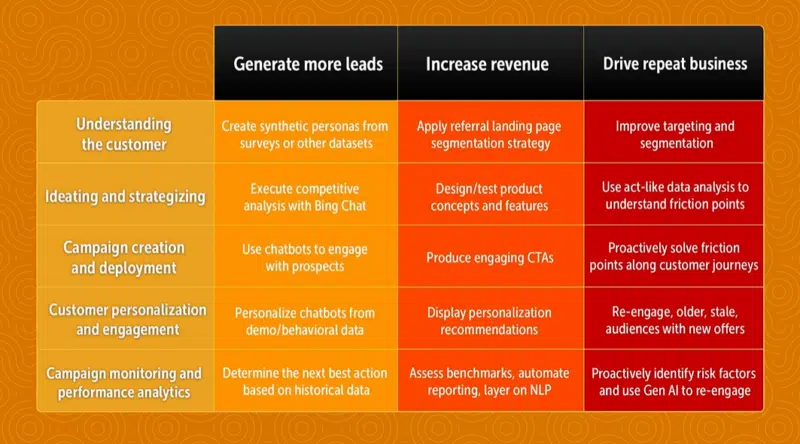Leveraging generative AI to improve customer experience and increase revenue: The MarTech Conference keynote
Microsoft’s Talisha Padgett shares her approach to infusing genAI across the customer journey in her keynote presentation at The MarTech Conference.
“Customer expectations will continue to grow year-over-year. How do we as marketers meet those expectations and set our brands apart?” asked Talisha Padgett, Microsoft’s general manager, martech platforms and AI, in her keynote kicking off Day 1 of The MarTech Conference. “I personally believe it’s all about infusing AI, from planning all the way through analytics, which will also enable a unique customer experience.”
Padgett cited a recent McKinsey report that projected genAI will contribute up to $4.4 trillion in annual global productivity. Furthermore, Sales and Marketing, combined, was flagged as one of four functional groups likely to deliver 75% of that value.
“That means, every time we engage with our customer and they’re engaging with our brand, it’s an opportunity for us to get better and to blow the customer’s mind,” said Padgett.
Where to infuse genAI in customer experience
Here are five stages across the marketing funnel where genAI can be used:
- Understanding the customer
- Ideating and strategizing
- Campaign creation and deployment
- Customer personalization and engagement
- Campaign monitoring and performance analytics
“Generative AI can help [marketers] at all five stages,” said Padget. “And you can have other stages, but that’s how I think about it.”
Furthermore, the ways marketers can infuse genAI at these stages fall into three main marketing goals for Padgett. The technology can be used to generate more leads, increase revenue and drive repeat business or loyalty.
Generating more leads with genAI
Marketers should adopt an experimental attitude toward new AI tools. When content production is increased to produce many variations, that allows brands to speak to customer segments in more customized ways. And these interactions create more data that helps marketers understand what works and what doesn’t. And these insights can bring in more leads.
Understanding the customer. Marketers can use natural language processing (NLP) to ask questions about existing customer data. One company Padgett is familiar with uses AI to build synthetic personas from composite data pulled from various datasets, including survey data and CRM, to learn more about their prospects and why they aren’t converting.
Strategy. GenAI tools like Bing Chat can be used to conduct competitive analysis and find out how competitors are reaching their audiences.
Campaign creation and deployment. Use genAI chatbots to create text and images for campaigns to improve engagement with prospects.
Customer personalization and engagement. Personalize the chatbot experience using demographic or behavioral data to make engagement with customers more relevant and speedy.
Campaign monitoring and performance analytics. Deploy a next-best-action engine with NLP that allows marketers and the data science team to ask questions about how best to optimize the customer experience and drive the very best actions.
“As long as a customer is finding value, the company is getting better engagement and you’re saving steps, that is a win for everyone,” said Padgett.
Using genAI to generate revenue
Chatbots and genAI tools increase the capability to create more personalized experiences and content rapidly. Marketers experimenting with these tools not only will be able to produce more variations, they’ll be able to test and validate what works. Winning combinations can be used more frequently, improving customer success.
Understanding the customer. Decrease abandon rate and increase order value by segmenting customers based on landing page referrals and tailoring the landing page experience according to these segments.
Strategy. Use genAI to create images of new products and features to rapidly test them on customers. These insights can be turned around quickly to build product roadmaps. Including your customers in this process can also get them enthusiastic about the brand and closer to purchase.
Campaign creation and deployment. Create new, even more relevant calls-to-action at scale that are inserted in genAI-produced ads and emails. When doing this, Padget recommended including a disclaimer — “content produced with AI — to signal to customers that they should expect some changes in product recommendations and format.
Customer personalization and engagement. Integrate genAI into a chatbot tool to provide personalized responses.
Campaign monitoring and performance analytics. Consider automating and consolidating campaign monitoring tools and layering NLP over it so members across the team can ask questions about performance. This makes monitoring more inclusive, and more hands will be on deck to tweak campaigns and bring in more sales.

Driving up repeat sales and loyalty with genAI
Organizations that use genAI to ramp up content production and messaging can execute targeted campaigns to more specific customer segments. That means that messaging is more personalized and aimed at specific friction points in the customer experience. Over time, a better customer experience will encourage retention and strengthen loyalty.
Understanding the customer. With the ability to scale up content production with genAI, marketers can test variations in creative on sub-segments and validate what works. “These are different ways in which you can build upon things that exist, but be very specific for your customer,” said Padgett.
Strategy. Create “act-like” messages aimed at customer segments facing specific friction points in the customer experience. When you speak to these frustrations, you will gain customers’ trust and loyalty.
Campaign creation and deployment. Anticipate friction points and proactively solve them with tailored messaging, experiences and chatbots.
Customer personalization and engagement. Use genAI to help create and launch a re-engagement campaign aimed at lapsed customers.
Campaign monitoring and performance analytics. Use historical data to discover frequent pain points and identify risks to losing customers. Create a campaign aimed at these risks so customers continue to be engaged.
“The difference with generative AI is you don’t have to be a developer or a data scientist to really leverage its powers,” said Padgett.
Go here to see the entire presentation. Registration is free.
Related stories